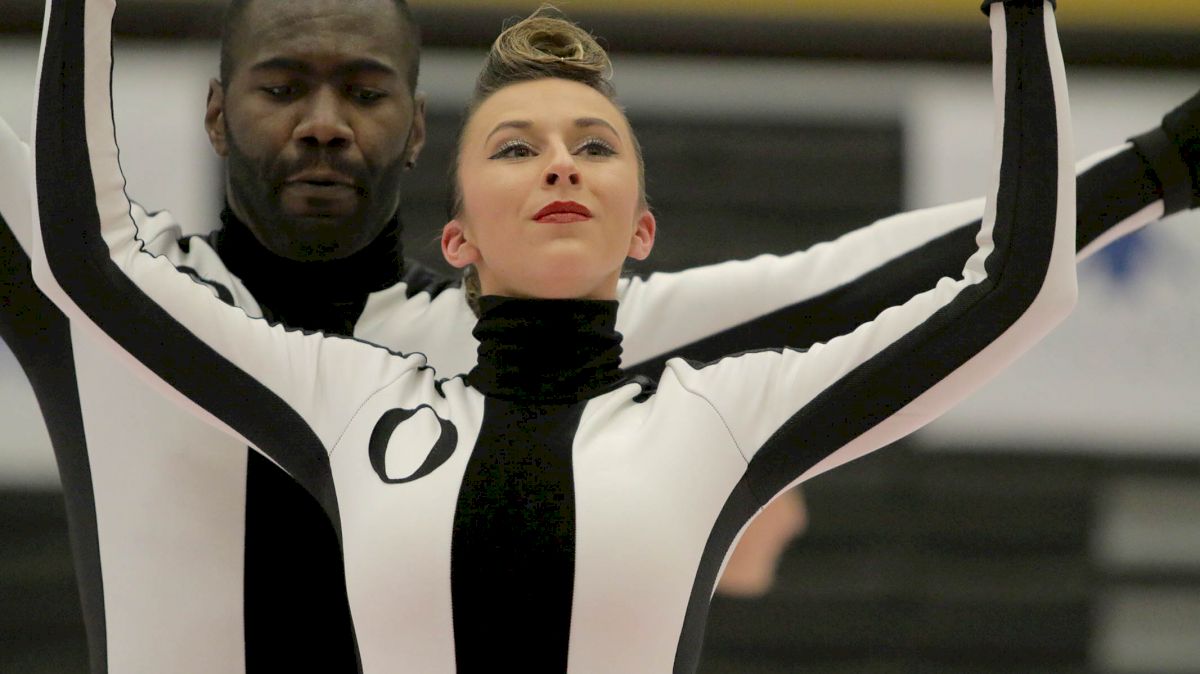‘A Year From Monday’: Onyx’s Ode To Minimalism
‘A Year From Monday’: Onyx’s Ode To Minimalism
Take a deeper look at Onyx's 2018 production, "A Year From Monday," as it prepares for the 2018 WGI World Championships.

Unlock this article, live events, and more with a subscription!
Already a subscriber? Log In
By Marcus J. Hopkins
Onyx Independent World Winter Guard has spent the better part of 15 years establishing its own brand as a unique performance ensemble. Its shows are consistently some of the most innovative, creative, and demanding shows in the industry, and this year’s offering—“A Year from Monday”—is no exception.
Onyx’s shows have rarely been designed in such a way that easily lends themselves to a linear description of events. Where many guard shows are broken down into a somewhat formulaic pattern (e.g. Opening Movement -> Introduction of equipment -> Weapon feature -> Standstill performance on primaries -> Ensemble flag feature -> Exeunt), Onyx has consistently presented shows that break that mold. As such, it’s often better to describe their shows more in terms of what appears to have inspired the design and writing; as a piece of art to be taken in.
From an outsider’s perspective, Onyx’s show seems to be about balance, reflection, and oppositional forces. The design choices for the floor and uniforms focus on establishing clean lines and bisected space—the floor’s red stripe divides the stage into equal parts; the performers’ uniforms divide their bodies into equal halves. Both are fantastic examples of artistic minimalism, an art movement that began in the post-World War II 1950s but saw its heyday in the 1960s and ‘70s. The floor, itself, is reminiscent of sculpture works by Donald Judd.
In terms of music and performance, minimalism is present, as well. The music is a classic example of minimalism—a series of slowly changing common chords in a steady rhythm, overlaid with a lyrical melody in long, arching phrases. The performers’ movement book is reminiscent of the work of Trisha Brown’s 1987 dance piece, “Newark.” Minimalism in dance often uses shorter phrases using carefully chosen, intricately developed steps. Much of Onyx’s choreography relies upon this technique — short, intricate phrases presented in small groups on both sides of the stage.
From the beginning, the design provides balance. The opening choreography is mirrored across the red line, with both sides A and B performing the same choreography on opposite sides. The design of the uniform — white with black lines that bisect the performers down the middle and highlight the lines of the arms and legs — work well with the white floor to create several optical effects, as the performers, themselves, seem to disappear and blend with the floor. Every section is balanced, at this point, with each movement on side A either mirrored or copied exactly by performers on the other side of the line.
This trend continues with the introduction of the rifle line — three rifles to a side, with small groups performing identical work or choreography on either side of the line. The location of the performers, in this piece, is just as important as the work they do, which is both tricky and well achieved. The rifle work makes good use of the entirety of the equipment, with lots of work involving the strap to propel the gun quickly around a stationary axis. Even here, the work, itself, is minimalist in its presentation: short, intricate phrases that require a high level of dexterity and execution.
When the first flags appear, they, too, are minimal — both literally and in terms of design. The ensemble flag — the one used by more than one member — is comprised of three strips of fabric (two large black strips and a single red strip), none of which are physically connected to the other. This design allows the floor to be seen through the center of the flag, whereas the solid blocks that typify normal flags would obscure the floor. It’s a bold design choice that works well with the rest of the unifying motif.
It is with the entrance of the solo flag performer, whose silk is the lone normal flag — a solid red silk with an unattached black strip that creates a curve down the top of the silk when the flag spins but dangles free when the performer stops spinning. This strip is often used by the performer to contrast the solid red block.
This soloist remains a soloist throughout the rest of the show, performing two spectacular moments with the silk in which he uses the end of the flag to propel it in a circular motion while lying on the floor and hopping his entire body over both flag and pole before standing. He then continues the circling of the flag, wrapping it around his body, and allowing the pole to come to a stop while in the attitude position — a shape pioneered by Carlo Blasis in the 19th century, using Giambologna’s statue of Mercury with its slightly bent leg as inspiration.
The show comes to a close with what is essentially a human sculpture. The soloist with the red flag performs, again, his body-hopping feat as the cast behind him builds a monument made of humans. He passes his flag to the person at the apex of the monument in total silence.
Marcus J. Hopkins has been involved in the marching arts as a performer and instructor since 1985. He majored in music education at West Virginia University and was a performer with Dobyns-Bennett Scholastic World Indoor Drumline (2000), The Cadets Drum and Bugle Corps color guard (2001-03), and Ad Astra Per Aspera Independent World Winter Guard (2005).